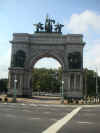 |
New York
Architecture Images- Park Slope, Brooklyn Grand Army Plaza Landmark |
|
architect |
Olmsted and Vaux |
|
location |
All Grand Army Plaza, within Plaza St. at the intersection of Flatbush Ave., Prospect Park W., Eastern Pkwy., and Vanderbilt Ave. |
|
date |
1870. |
|
style |
Beaux-Arts |
|
type |
Monument |
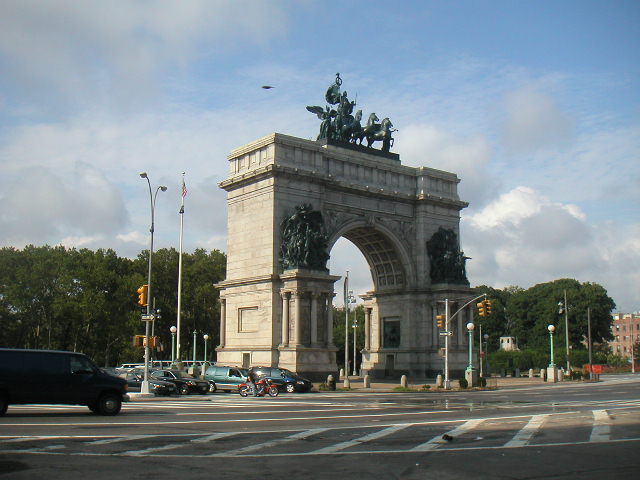 |
|
| The Quadriga - Columbia in her chariot | |
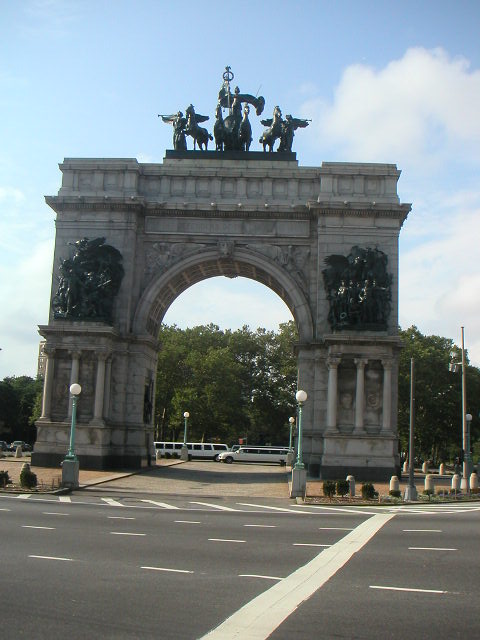 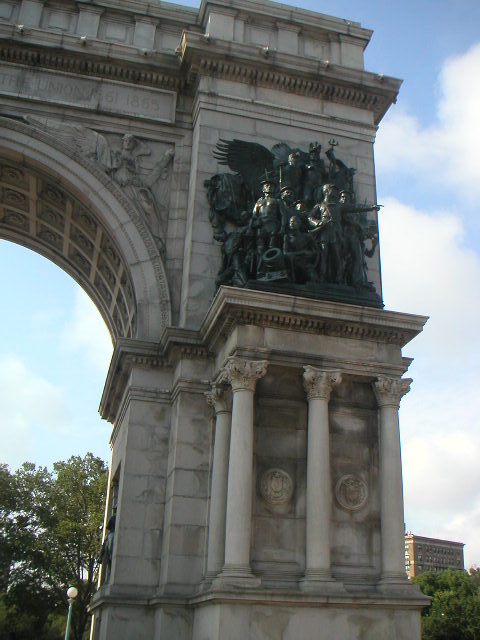 |
|
| The traffic circle around Grand Army Plaza at the main entrance to Prospect Park | |
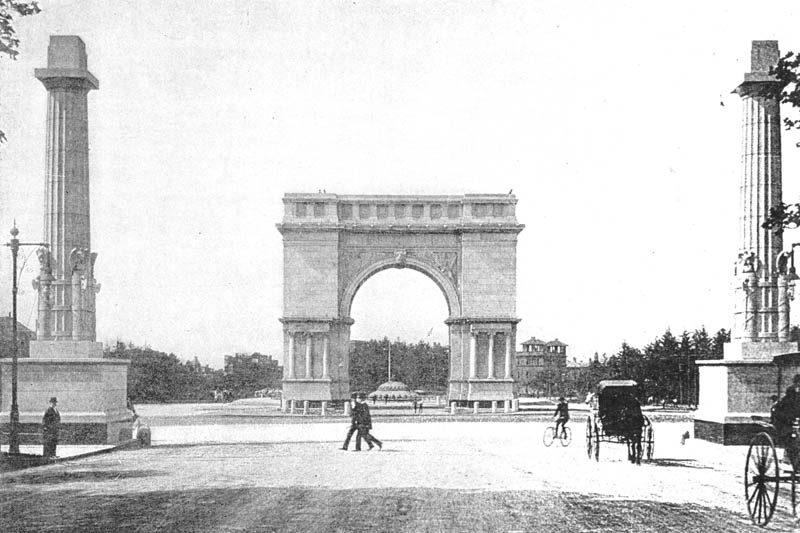 |
|
| The Arch in 1894, before the installation of statuary. | |
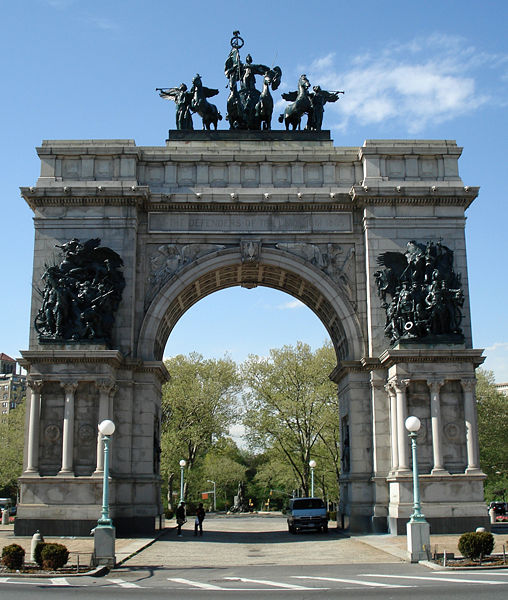 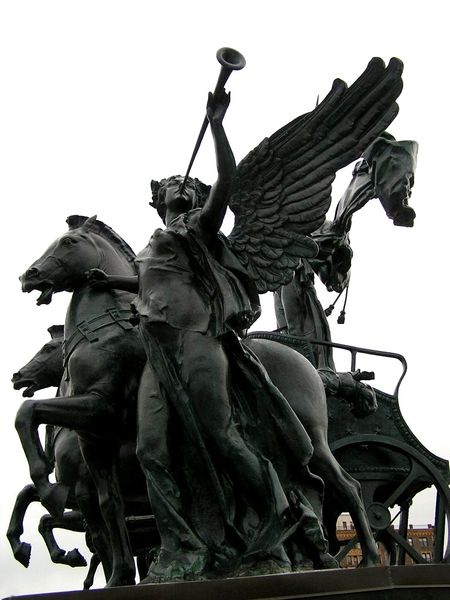 |
|
| The Soldiers' and Sailors' Arch at Grand Army Plaza and Heralding Victory - a side view from atop the Arch | |
|
|
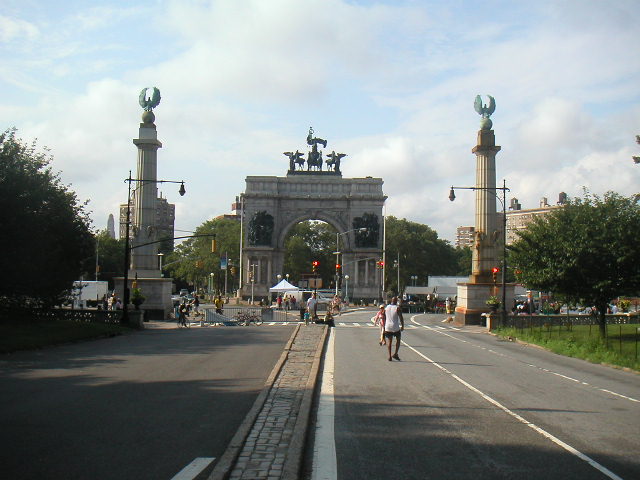 |
|
|
 |
 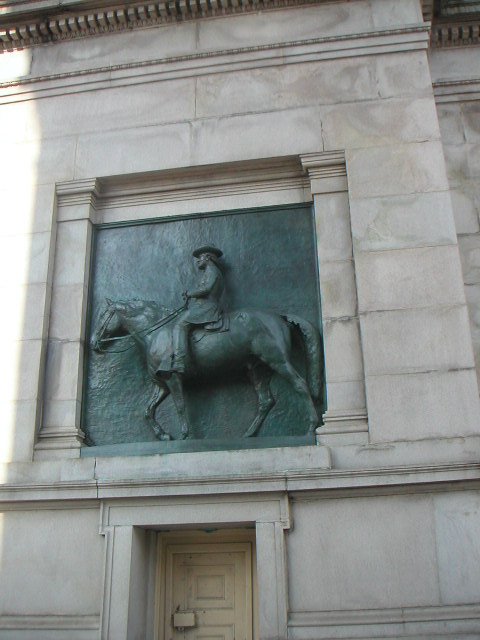 |
|
| 'Lincoln and Grant', bronze sculptures by William Rudolf O'Donovan (men) & Thomas Eakins (horses), 1893-1894, Grand Army Plaza, Brooklyn, New York City | |
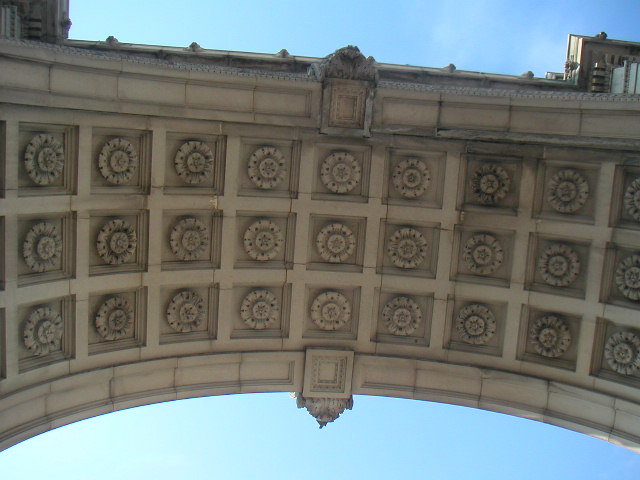 |
|
 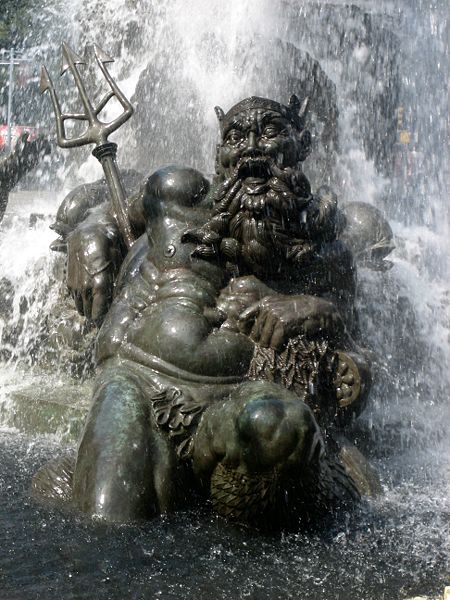 |
|
| Bailey Fountain, Grand Army Plaza, Brooklyn, New York, by sculpture , Eugene Francis Savage, 1932 | |
|
Grand Army Plaza is also the name of a plaza at the intersection of 59th
Street and 5th Avenue in front of the Plaza Hotel in Manhattan, and
opposite the southeastermost corner of Central Park. It is the site of a
fountain contributed by Joseph Pulitzer [1] Grand Army Plaza in Brooklyn, New York is an 11-acre (4.4 hectare) oval plaza that forms the main entrance to Prospect Park. It was designed by Frederick Law Olmsted and Calvert Vaux in 1867. It consists of concentric rings arranged as streets, with the outer ring being named Plaza Street. The inner ring was originally intended to be a circle, but it actually was arranged as a main street – Flatbush Avenue – with eight radial roads connecting: Vanderbilt Avenue; Butler Place; Saint John’s Place (twice); Lincoln Place; Eastern Parkway; Prospect Park West; Union Street; and Berkeley Place. As completed, the only streets that penetrate to the inner ring are Flatbush Avenue, Vanderbilt Avenue, Prospect Park West, Eastern Parkway, and Union Street. Originally known as Prospect Park Plaza, but renamed in 1926,[2] it is perhaps best known for the Soldiers' and Sailors' Memorial Arch, Brooklyn’s version of the Arc de Triomphe. It is also the site of the Bailey Fountain, and a monument to John F. Kennedy, as well as statues of Civil War generals Gouverneur Kemble Warren and Henry Warner Slocum, along with busts of notable Brooklyn citizens Alexander J.C. Skene and Henry W. Maxwell.[3] The Arch Prospect Park Plaza (as it was originally known) was conceived by its designers, Frederick Law Olmsted and Calvert Vaux, simply as a grand entrance to the Park. It was meant as a gateway, to separate the noisy city from the calm nature of the Park. Olmsted and Vaux's design included only a single-spout fountain surrounded by berms (earth embankments) covered in heavy plantings. They still shield the local apartment buildings and the main branch of the Brooklyn Public Library from the noisy traffic circle that has developed. On 1889-08-06, A blind jury of two experts, appointed by the Soldiers and Sailors Monument Commission, selected the design of John H. Duncan from a field of thirty six entries that had been submitted the previous year. [4] Duncan, who would go on to design Grants Tomb in the following decade, proposed a free-standing memorial arch of a classical style similar to the Arc de Triomphe in Paris. After two and a half months of site preparation, William Tecumseh Sherman laid the cornerstone of the arch on 1889-10-30. After almost three years of construction, President Grover Cleveland presided over the unveiling on 1892-10-21 [5]. Statuary and fountain Inside the arch and on facing walls are equestrian relief sculptures of Abraham Lincoln and Ulysses S. Grant. William Rudolf O'Donovan (1844-1920) sculpted both men and Thomas Eakins (1844-1916) did the two horses. The Arch gained its monumental statues nine years later. They were first suggested by the architectural firm of McKim, Mead and White as part of a plan to formalize the plaza in the spirit of the City Beautiful movement. Park Commissioner Frank Squire liked the proposal and in 1894 engaged Frederick MacMonnies to design three sculptural groupings for the Arch, the Quadriga, The Spirit of the Army, and The Spirit of the Navy. The Quadriga resides at the top and depicts the lady Columbia, an allegorical representation of the United States, riding in a chariot drawn by two horses. Two winged Victory figures, each leading a horse, trumpets Columbia's arrival. The lower pedestals facing the park hold the Spirit of the Army group and the Spirit of the Navy group. Installation of the groups began four years later, starting with the Quadriga on December 4, 1898, and finishing with the Navy group on April 13, 1901. The work took nearly seven years to complete, about twice as long as the construction of the arch itself. Just north of the Arch, and away from Prospect Park, stands Bailey Fountain, the fourth fountain to occupy the site. The original 1867 fountain, featuring a lone jet of water, was replaced in 1873 by Calvert Vaux's Plaza Fountain.[6] Vaux's Plaza Fountain was a two-tier, double-domed, circular structure constructed from cast iron and molded sections of Beton Coignet.[7] Vaux placed gaslights in the 37.2 foot (11.4 meter) diameter dome,[7] each visible through one of 24 colored glass windows for evening illumination.[8] Additional gaslights mounted in the guardrail illuminated the surface of the pool.[9][10] With such abundant gas lighting and a flow rate of 60,000 gallons an hour, Brooklynites were enthralled with the fountain. It became the plaza's focal point, though Brooklyn Mayor John W. Hunter criticized the fountain's extravagant use of water.[11] Vaux's extravagant fountain did not age well; by the 1890's it leaked and was frequently dry.[12][13] In its place, rose Fredric W. Darlington's[14] Electric Fountain, a multi-colored electrically lit fountain that was greeted with some wonder in an era when electricity was still in its infancy. Park Commissioner Frank Squire had originally planned to replace Vaux's Plaza Fountain with an unobtrusive, single-spout affair that would not obstruct a view of the arch from Flatbush and Vanderbilt avenue approaches. However, Darlington's detailed plans, presented in May, 1897, and quick responses to questions from Brooklyn Bridge chief engineer C. C, Martin swayed the Park Commission to invest in the electric fountain.[15] Darlington's design called for a flow rate of 100,000 gallons an hour, but, using a circular pump, it would make few demands on the capacity of the nearby Mount Prospect Reservoir.[16] [17] It featured nineteen 6,000 candlepower electric arc lights, wired in three series circuits, with each circuit controlled by its own dimming rheostat. Each arc lamp could be remotely focussed in narrow and intense, or soft and wide beams. These were housed beneath the water's surface in an underground chamber and projected through a thick glass ceiling into the water jets above. The arc lamps were laid out in concentric rings around a central light and spout. The hydraulics consisted of over 2,000 separate jets, also below the surface. Many were situated in rings around the electric lamps and had various kinds of nozzles for different effects.[13] Enchantingly, a lighting conductor could impart distinct colors to each of the nineteen lamps through rotating wheels of colored gels. A second hydraulic conductor managed the fountain's spouts. Both operated from an underground control room located just off the south end of the basin, near the arch. The operators could view their efforts through three closely spaced windows set in the basin wall just above the water's surface.[18] [19] The fountain was situated in a 120 foot diameter basin. Landscape architect Frederick Law Olmsted placed the fountain at the intersection of two broad paths, arranged as a Georgian cross, with grassy, treeless plots situated at the quadrants. Attendance on opening night, 1897-08-07[20] was around 100,000 people, and regularly scheduled performance on Wednesdays and Saturdays generally drew 20,000 to 30,000 spectators. In an era when most homes were still gaslit, the shifting colors and ever-changing spouts of the electric fountain invoked an awe and sense of wonder that is hard to grasp today.[21] The Electric Fountain's career was brief – a mere eighteen years. It was removed during the 1915 construction of the IRT subway under the Plaza and was not restored; the subway tunnel left no room for the infrastructure which the electric fountain required.[22] For over a decade, no fountain occupied the Plaza; it remained a grassy, treeless oval. The Bailey Fountain is, approaching seventy five years, the fourth and longest lasting plaza fountain. It was built in 1932 by architect Edgerton Swarthout and sculptor Eugene Francis Savage (1883-1978). Named after Brooklyn-based financier and philanthropist Frank Bailey (1865-1953), he funded it as a memorial to his wife Mary Louise. It features an elaborate grouping of allegorical and mythical figures that includes the god of water Neptune and a pair of nudes, one male, one female, representing Wisdom and Felicity. [5] It is a frequent backdrop for Wedding photography. The Baily Fountain was renovated in 2005 and 2006 by the Prospect Park Alliance.[23] Current use The Soldiers' and Sailors' Monument received landmark designation in 1973; in 1975, all of Grand Army Plaza became a New York City historic landmark. In 1976 the Lady Columbia figure on the Quadriga fell out of its chariot, underscoring the need for restoration of the then seventy-eight year old installation. The Arch was restored in 1980 and again in 2000. The interior of the Arch is usually closed to visitors, but is sometimes opened for art shows and performances held inside. Only the eastern end is ever open to the public, with a staircase leading to a platform at the top by the Quadriga. The symmetrical western end, with its degraded stairway, is only used for storage. The area around the Arch forms the largest and busiest traffic circle in Brooklyn, being the convergence of Flatbush Avenue, Vanderbilt Avenue, Eastern Parkway, Prospect Park West, and Union Street. In decades past, the circle hosted Brooklyn's "Death-O-Meter", a sign admonishing drivers to "Slow Up" and displaying a continually updated tally of traffic accident deaths in the borough. For the past several years a Green Market, referred to as the 'Farmer's Market' by residents, is held on the Plaza in front of Prospect Park every Saturday from 8 a.m. to 4 p.m.. On weekends a free tourist trolley service runs between noon and 6 p.m. from Grand Army Plaza with stops at the Brooklyn Botanic Garden, the Boathouse, the Wollman Rink and the Brooklyn Museum. The Grand Army Plaza subway station is on the north end of the Plaza and furnishes transportation to the site and the nearby park. References ^ Kenneth T. Jackson:The Encyclopedia of New York City: The New York Historical Society; Yale University Press; 1995. P. 497-498. ^ New York Times, Plaza in Brooklyn Dedicated to G.A.R., May 10, 1926, page 9 ^ "Henry W. Maxwell Dead; Succumbed To Apoplexy", The Brooklyn Daily Eagle, Brooklyn Daily Eagle, 1902-05-12, pp. Page 1, Column 7, continues on page 2, column 1. Retrieved on 2006-10-16. (english) Henry W. Maxwell (December 7, 1850 – May 11, 1902) died suddenly of what was termed at the time as 'Apoplexy.' A private subscription raised funds to place a memorial tablet to Maxwell in what was in what was once Sunset Park, now the present site of the central branch of the Brooklyn Public Library. The memorial was moved to the intersection of St. John's Place and Plaza Street East in 1912; it was moved again to the Brooklyn Museum for restoration in the 1970s and a replica put in its place. A historical marker on Grand Army Plaza cites the name of the memorial, 'Henry Maxwell Tablet', but this is often read as Maxwell's name instead, and was reproduced as such in earlier versions of this article. It is perhaps an indication of how a once well-known individual has slipped into anonymity that such a mistake can be made. See Henry Maxwell Monument at the NY Parks Department web site for more information, as well as the contemporary news report on his death in the Brooklyn Daily Eagle. ^ Jurors William R. Ware and Charles B. Atwood had been appointed earlier in the year by the three person Commission, comprised of Brooklyn Mayor Alfred C. Chapin, Aldermanic President McCarty, and Grand Army of the Republic Memorial Committee Chairman James D. Bell "Lucky Man: A New Yorker Gets the Soldier's Monument Work", The Brooklyn Daily Eagle, Brooklyn Daily Eagle, 1889-08-06, pp. Page 4, Column 2. Retrieved on 2007-01-09. (english) ^ a b White, Norval & Willensky, Elliot; AIA Guide to New York City, 4th Edition; New York Chapter, American Institute of Architects; Crown Publishers/Random House. 2000. ISBN 0-8129-31069-8; ISBN0-8129-3107-6. P.723—730. ^ "The Plaza Fountain", The Brooklyn Daily Eagle, Isaac Van Anden, 1873-11-15, pp. Page 6 Column 4. (english) ^ a b Beton Coignet was a method of preparing a very durable concrete which, nonetheless, lent itself to very detailed molds. At the time, the process was thought to rival the very best stonecutting, but was a much cheaper process. The interior of the Cleft Ridge Span in Prospect Park, near the Audubon Center at the Boathouse, is a surviving example. "Artificial Stone", The Brooklyn Daily Eagle, Isaac Van Anden, 1873-08-29, pp. Page 2 Column 5. (english) ^ (2001) The complete illustrated guidebook to Prospect Park and the Brooklyn Botanic Garden. Silver Lining Books, Pages 32 - 36. ISBN 0-7607-2213-7. ^ Rigby, Joe. "Illumination Night at the Plaza Fountain, Prospect Park", The Brooklyn Daily Eagle, The Brooklyn Daily Eagle, 1895-10-13, pp. page 21 Column 2. (english) ^ "Prospect Park: The Fountain at the Plaza", The Brooklyn Daily Eagle, The Brooklyn Daily Eagle, 1874-06-02, pp. 4 column 5. (english) ^ Hunter also took aim at Stranahan's proposed disposition of the 'East side lands,' the package north of Flatbush Avenue that had been purchased to fufill Egbert Viele 1861 plan for Mount Prospect Park, but which had been excluded from Olmsted and Vaux's 1866 plan. The change put land titles in doubt and the issue dragged on until the consolidation of the City of Brooklyn into Greater New York. "Municipal. The Mayor Viewing the Park From a Lofty Standpoint", The Brooklyn Daily Eagle, The Brooklyn Daily Eagle, 1874-06-23, pp. 2 column 3. (english) ^ Tragically, Albert Plum, a ten year old boy drowned in the fountain in June, 1895. It is possible that the death could have been adverted, but the attending police officer, unaware of anything amiss, drove would-be rescuers from the pool by drawing his service revolver, intent on rigorously enforcing the Park ban on people wading in the fountain pool. Under this grim pall, the death of a child and the censure of the police officer, the Plaza Fountain remained dry for most of its final year of existence. "Problem of the Plaza", The Brooklyn Daily Eagle, Brooklyn Daily Eagle, 1895-03-31, p. 4, Column 4. Retrieved on 2007-01-09. (english) ^ a b "A Fine New Park Plaza", The Brooklyn Daily Eagle, Brooklyn Daily Eagle, 1897-01-27, p. 14, Column 5. (english) ^ Darlington was an electrical engineer from Philadelphia who made his money electrifying horse-propelled street railways and designing street lighting, a trade that had taken him as far afield as Japan. But he also built decorative electric fountains, typically in amusement parks at the ends of trolley lines. In the 1890's, he had erected electrified fountains in locales as diverse as Willow Grove Park in Willow Grove, PA, and the Crystal Palace in London. "F. W. Darlington, Engineer, Inventor", The New York Times, New York Times, Inc., 1947-07-25. (english) ^ "An Electric Fountain", The Brooklyn Daily Eagle, Brooklyn Daily Eagle, 1897-05-12, p. page 3, Column 4. (english) ^ The reservoir and attendant water tower was demolished in 1935; the site is now occupied by Mount Prospect Park. ^ (1900) in Albert Kelsey: Street Pagentry, 2nd, 931 Chestnut Street, Philadelphia PA: The Architectural Annual, 233 - 240. ^ "Our Newest Electric Toy", The Brooklyn Daily Eagle, Brooklyn Daily Eagle, 1897-08-08, pp. 13, Column 2. (english) ^ Grand Army Plaza - History. Prospect Park Aliance. ^ "The new electric fountain near the arch in Prospect Park, Brooklyn, attracts large crowds nightly, and although it has been in operation for two weeks, custom does not seem to stale its infinite variety. The dazzling brilliancy of the lights, the quickness with which the colors are changed and the beautiful rainbow effects which the skillful operator in charge of the electric buttons manages to obtain are magnets which draw spectators from near and far. On the opening night, fully 100,000 people watched the display. As soon as there is sufficient darkness there is a sound of rushing water, and a great white column rises into the air. About it are started other and smaller columns of water, falling toward the centre. After a few moments under the white light the colors are changed, and brilliant reds, blues, and greens chase each other through the falling spray, and, intermingling, form a panorama which is the delight of all the residents of Brooklyn." — New York Mail and Express. August, 1897 ^ GRAND ARMY PLAZA - Historical Sign (Hypertext Markup Language). Historical Signs. City of New York (2001-12-14). Retrieved on 2007-05-24. ^ There are a few examples of Darlington's work that still survive. The Friends of the Electric Fountain, a group in Denver, Colorado are rebuilding the Prismatic Fountain at Feril Lake and hope to have it operating by its centennial, May 30, 2008. The 1908 original had been built by Darlington. The present example follows Darlington's design, but the mechanicals employ present day techniques. The Garfield Park Conservatory and Sunken Gardens in Indianapolis, Indiana also has a restored electric fountain constructed in 1916.F. W. Darlington's Electric Fountain. The Friends of the Electric Fountain (2006-02-24). ^ (2006) Prospect Park Alliance Annual Report 2006 (PDF (Portable Document Format)), New York: Prospect Park Alliance, 8. Retrieved on 2008-01-11. Books Lancaster, Clay; (1967, 1972 ). Prospect Park Handbook Greensward Foundation, Inc. ISBN 0-913252-06-9 Berenson, Richard J. (ed); deMause, Neil (text); (2001). The complete illustrated guidebook to Prospect Park and the Brooklyn Botanic Garden Silver Lining Books, New York ISBN 0-7607-2213-7 Pages 32 - 36 Newspapers (October 30, 1889). "Tecumseh's Warm Greeting" The Brooklyn Daily Eagle Page 6 (December 4, 1898). "Quadriga in its Place" The Brooklyn Daily Eagle Page 31 (April 13, 1901). "Navy Group in Place; Arch is Now Complete" The Brooklyn Daily Eagle Page 2 |
|
|
Olmsted & Vaux designed this monumental oval traffic circle in the
spirit of Paris’ Etoile (now the Place Charles de Gaulle), that circular
12-spoked traffic rond point that bears in its central island the Arc de
Triomphe, although they opposed an arch here. A masterstroke of city
planning, this nexus joins their great Eastern Parkway, and their
Prospect Park, with the avenues that preceded it on other geometries.
This triumphal arch did not arrive for 22 years: the Soldiers’ and
Sailors’ Memorial Arch
W by John H. Duncan, architect of Grant’s Tomb, was built between
1889 and 1892, commemorating Union forces that perished in the Civil
War. The arch provided, as in its Parisian inspiration, an excellent
armature for sculpture, planned by Stanford White (McKim, Mead & White.
1894-1901), the most spectacular of which is Frederick MacMonnies’ huge
quadriga on top (1898). Inside the arch itself is more subtle work,
bas-reliefs of Lincoln (Thomas Eakins) and Grant (William O’Donovan),
both installed in 1895. On the south pedestals are two bristling groups
representing The Army and The Navy by MacMonnies (1901). A museum within
the arch is open to the public.
The oval island to the north of the arch is of a more homely scale, with
a double ring of formally trimmed London plane trees surrounding a
generous complex of stairs and terraces, and a fountain. Around the John
E Kennedy Memorial at the north end (1965, Morris Ketchum, architect,
Neil Estern, sculptor), the scale shrinks noticeably. This little
memorial, the city’s only official monument to Kennedy, was originally
designed as a monolithic marble cube topped by a flame on top, but it
was later abandoned as an unsuitable aping of the perpetual flame at
Arlington Cemetery’s Tomb of the Unknown Soldier. This present form is a
compromise, with Kennedy’s bust bracketed from the side. Budget makers
demeaned it all by causing the cube to be merely a box built of thin
butted marble slabs. The Bailey Fountain (1932, Egerton Swartwout,
architect; Eugene Savage, sculptor), a lush interweaving of athletic
Tritons and Neptunes in verdigris bronze, is a delight when in action
(unfortunately rarely in this water-conscious city).
While the arch was being embellished, a necklace of Classical ornaments,
designed by Stanford White, was strung across the park entrances facing
it (completed in 1894). Rising out of entangling fasces, four 50-foot
Doric columns are topped with exuberant eagles (by MacMonnies),
railings, bronze urns, and lamp standards; and two 12-sided temple-like
gazebos. Of the whole ensemble, the gazebos, with their polished granite
Tuscan columns, Guastavino vaulting, and bronze finials, show White’s
talents most richly. |
|
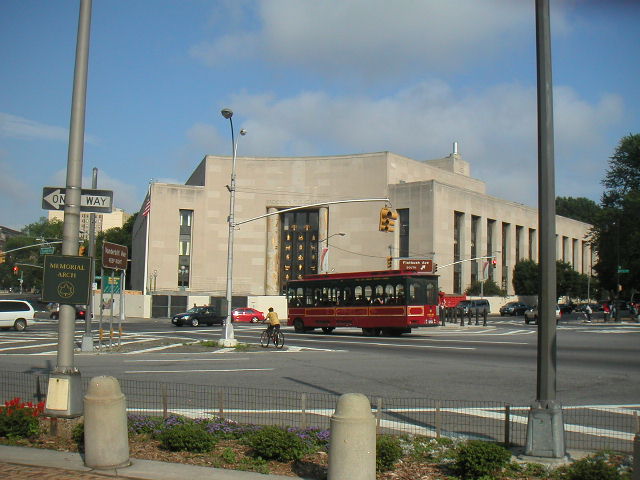
|
|
| with thanks to "The AIA Guide to New York", | |